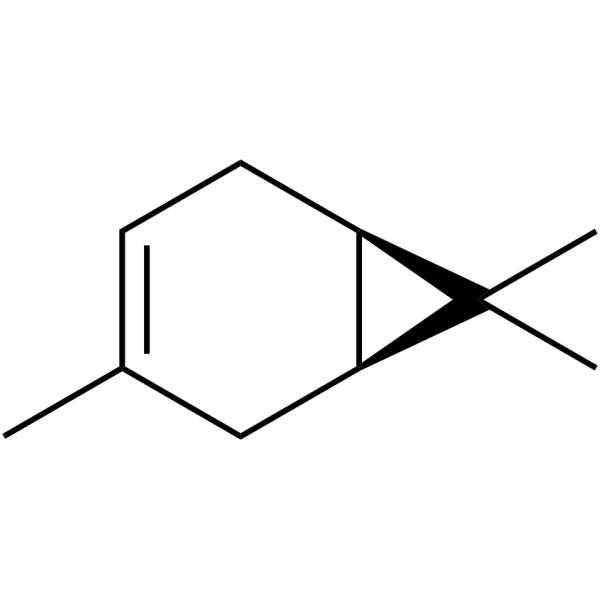(+)-D-3-Carene

(+)-D-3-Carene structure
|
Common Name | (+)-D-3-Carene | ||
|---|---|---|---|---|
| CAS Number | 498-15-7 | Molecular Weight | 136.23 | |
| Density | 0.865 | Boiling Point | 170-172ºC | |
| Molecular Formula | C10H16 | Melting Point | N/A | |
| MSDS | Chinese USA | Flash Point | 55ºC | |
| Symbol |



GHS02, GHS07, GHS09 |
Signal Word | Warning | |
|
Mechanisms for the formation of organic acids in the gas-phase ozonolysis of 3-carene.
Phys. Chem. Chem. Phys. 11(21) , 4184-97, (2009) This paper describes experimental studies aimed at elucidating mechanisms for the formation of low-volatility organic acids in the gas-phase ozonolysis of 3-carene. Experiments were carried out in a static chamber under 'OH-free' conditions. A range of multif... |
|
|
Antioxidant and antiacetylcholinesterase activities of some commercial essential oils and their major compounds.
Molecules 16(9) , 7672-90, (2011) The commercial essential oils of Citrus aurantium L., Cupressus sempervirens L., Eucalyptus globulus Labill., Foeniculum vulgare Mill. and Thymus vulgaris L., isolated by steam distillation by a company of Morocco were evaluated in terms of in vitro antioxida... |
|
|
Asymmetric synthesis of α-methyl-α-amino acids via diastereoselective alkylation of (1S)-(+)-3-carene derived tricyclic iminolactone.
J. Org. Chem. 76(6) , 1621-33, (2011) A novel carene-based alanine-equivalent tricyclic iminolactone 16 has been synthesized via stereoselective dihydroxylation of the double bond, IBX oxidation of the secondary alcohol, esterification of the tertiary alcohol, deprotection of the resulting ester,... |
|
|
Sensitive monitoring of monoterpene metabolites in human urine using two-step derivatisation and positive chemical ionisation-tandem mass spectrometry.
Anal. Chim. Acta 793 , 26-36, (2013) A gas chromatographic-positive chemical ionisation-tandem mass spectrometric (GC-PCI-MS/MS) method for the simultaneous determination of 10 oxidative metabolites of the monoterpenoid hydrocarbons α-pinene, (R)-limonene, and Δ(3)-carene ((+)-3-carene) in human... |
|
|
Low concentration of 3-carene stimulates the differentiation of mouse osteoblastic MC3T3-E1 subclone 4 cells.
Phytother Res. 22(1) , 18-22, (2008) Recently, natural products have gained more interest as alternative treatments for metabolic bone disorders and for the maintenance of bone health. In this study, the anabolic activities of 89 natural compounds were evaluated by measuring the amount of newly ... |
|
|
Genotoxicity of citrus wastewater in prokaryotic and eukaryotic cells and efficiency of heterogeneous photocatalysis by TiO(2).
J. Photochem. Photobiol. B, Biol. 108 , 8-15, (2012) The presence of (±)α-pinene, (+)β-pinene, (+)3-carene, and R-(+)limonene terpenes in wastewater of a citrus transformation factory was detected and analyzed, in a previous study, by using Solid Phase Micro-extraction (SPME) followed by GC analyses. Purpose of... |
|
|
A facile and efficient synthesis of 3,3-dimethyl isopropylidene proline from (+)-3-carene.
J. Org. Chem. 75(4) , 1285-8, (2010) A highly efficient and practical route to 3,4-isopropylidene proline I, starting from (+)-3-carene, was developed. The three continuous stereocenters were constructed using the inherent chirality of the starting natural product 2. The overall yield for the 12... |
|
|
Physical and chemical responses of Sitka spruce (Picea sitchensis) clones to colonization by Heterobasidion annosum as potential markers for relative host susceptibility.
Tree Physiol. 27(12) , 1701-10, (2007) Forty-one 2-year-old clones of Picea sitchensis (Bong.) Carr. from three full-sib families (14 clones from each of two families and 13 clones from a third family) were either wounded and inoculated with an isolate of Heterobasidion annosum (Fr.) Bref. or woun... |
|
|
Electrophysiological and behavioral responses of the bark beetle Dendroctonus rhizophagus to volatiles from host pines and conspecifics.
J. Chem. Ecol. 38(5) , 512-24, (2012) The bark beetle Dendroctonus rhizophagus is endemic to northwestern Mexico where it kills immature pines < 3 m tall. We report the first investigation of the chemical ecology of this pest of forest regeneration. We used GC-EAD to assess olfactory sensitivity ... |
|
|
Pyrazole derived from (+)-3-carene; a novel potent, selective scaffold for sphingosine-1-phosphate (S1P(1)) receptor agonists.
Bioorg. Med. Chem. Lett. 20(1) , 35-7, (2010) High throughput screening and hit to lead optimization led to the identification of 'carene' as a promising scaffold showing selective S1P(1) receptor agonism. In parallel to this work we have established a pharmacophore model for the S1P(1) receptor highligh... |